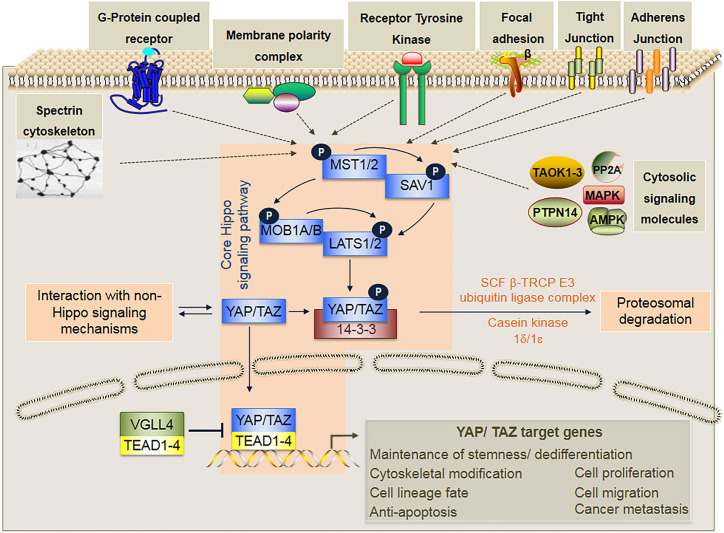FIGURE 2.
In mammals, the core Hippo signaling pathway is a kinase cascade composed of MST1/2, LATS1/2, SAV1, MOB1A/B, YAP/TAZ, the 14-3-3 protein that binds only to phosphorylated YAP/TAZ, and the TEAD transcription factors (TEAD1-4) that activates transcription of specific target genes upon binding to unphosphorylated YAP/TAZ. Activation of the core Hippo signaling cascade occurs through phosphorylation of either MST1/2 or LATS1/2 by various upstream signaling mechanisms that may involve various cytosolic signaling molecules (i.e., PP2A, TAOK1/2/3, MAPK, AMPK, and PTPN14), Adherens junctions (AJs), Tight junctions (TJs), Focal adhesions (FAs), Receptor tyrosine kinases (RTKs), Membrane polarity complexes (i.e., Crumbs, Scribble, aPKC-PAR) G-protein coupled receptors (GPCRs), and Spectrin cytoskeleton. Phosphorylation of YAP/TAZ inhibits nuclear translocation, and ultimately leads to proteasomal degradation via further phosphorylation of YAP/TAZ by casein kinase 1δ/1ε and ubiquitination by the SCF β-TRCP E3 ubiquitin ligase. By contrast, when the core Hippo signaling cascade is not activated, YAP/TAZ remain unphosphorylated and are translocated to the cell nuclei where they bind to TEAD transcription factors (TEAD1-4) and subsequently activate transcription of specific target genes that are involved in diverse cellular functions. Within the cell nuclei, VGLL4 can repress target gene expression by acting as a competitive inhibitor of YAP/TAZ binding to TEAD transcription factors.

